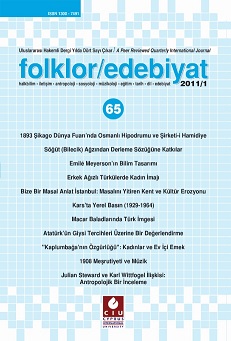Macar Baladlarında Türk İmgesi
The Image of Turk in the Hungarian Ballads
Author(s): F. Gülay MirzaoğluSubject(s): Cultural history, Customs / Folklore, Poetry, Oral history, Social history, Hungarian Literature
Published by: Uluslararası Kıbrıs Üniversitesi
Keywords: Oral poetry; ballad; folk song; Turks’ image; Turkish-Hungarian relations;
Summary/Abstract: Throughout the history, Hungarians having relations with Turks as their common geography settled Volga region the Kuban River from Eurasian plains had entered under the domination of the Caspian, at the end of the 9th century they immigrated to today’s homes. Besides Budin invasion by the Turks in 1686 and Hungary’s was brought under control, the fact that 150-year siege to take place has left several features will forever impact in the Hungarian culture and language. Within the context of Turkish-Hungarian cultural interaction the data showing the effects of Turkish in the Hungarian culture, in addition to traditions and vocabulary, the narrations such as legends, folk tales in oral literature involve. However, until today, in the frame of Turkish-Hungarian relations among these oral narrations shows the relations between two nations, what is unknown genre -especially in Türkiye- in oral literature is the ballad. In European culture, one of the genres in oral literature and oral music which is one of the basic types of ballad, a story told with music that often anonymous and unique musical narrative is a kind of radical. This limited study, compiled by the Hungarian oral culture is described in a sample group of ballads, old style that characterized the nature of the motion is attributed to the type of Turk, the image of Turk will be tried to portray. The basic data used and reviewed examples of the Hungarian ballad, is based on Hungarian Ballads and the European Ballad Tradition with his two-volume immortal work by Lajos Vargyas, the most comprehensive research on Hungarian folk ballads and the study of Ildikó Kriza (1980) Hungarian Folk Ballads and Nepdalok es Balladak Egyal-Dunai Szekely Közössegböl by Ujvary Zoltan (1968) who researched on the various aspects of Turk figures in Hungarian folk theater. In addition, another study of Lajos Vargyas (2005) Europa Diakkönyvtar/ Magyar Nepballadak.
Journal: Folklor/Edebiyat
- Issue Year: 17/2011
- Issue No: 65
- Page Range: 97-120
- Page Count: 24
- Language: Turkish

